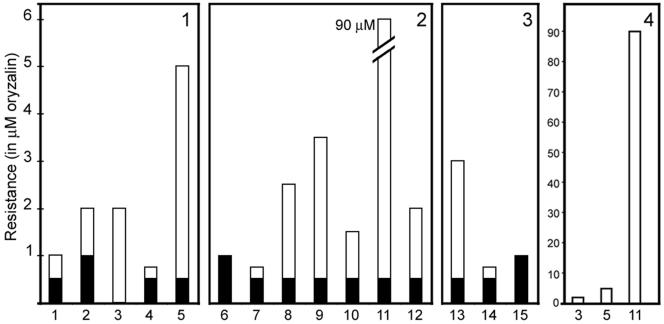Figure 3.
Degree of oryzalin resistance was assessed for lines transformed with the α-tubulin constructs. The resistance of both homologous integrations (allelic replacements) and nonhomologous integrations (pseudodiploids) was measured for each construct. Allelic replacements (white bars) show greater oryzalin resistance than do pseudodiploids (black bars). Panel 1, single mutations (1) Ser165Pro, (2) Ser165Thr, (3) Ser165Ala, (4) Ile231Thr, and (5) Thr239Ile. Panel 2, double mutations (6) Ser165Pro/Ile231Thr, (7) Ser165Pro/Thr239Ile, (8) Ser165Thr/Ile231Thr, (9) Ser165Thr/Thr239Ile, (10) Ser165Ala/Ile231Thr, (11) Ser165Ala/Thr239Ile, and (12) Ile231Thr/Thr239Ile. Panel 3, triple mutations (13) Ser165Pro/Ile231Thr/Thr239Ile, (14) Ser165Thr/Ile231Thr/Thr239Ile, and (15) Ser165Ala/Ile231Thr/Thr239Ile. Allelic replacements of Ser165Pro/Ile231Thr and Ser165Ala/Ile231Thr/Thr239Ile were not obtained nor were nonhomologous integrations of Ser165Ala and Ser165Pro/Ile231Thr. Panel 4, synergism of the double point mutation Ser165Ala/Thr239Ile. (3) Ser165Ala, (5) Thr239Ile, and (11) Ser165Ala/Thr239Ile lines.

